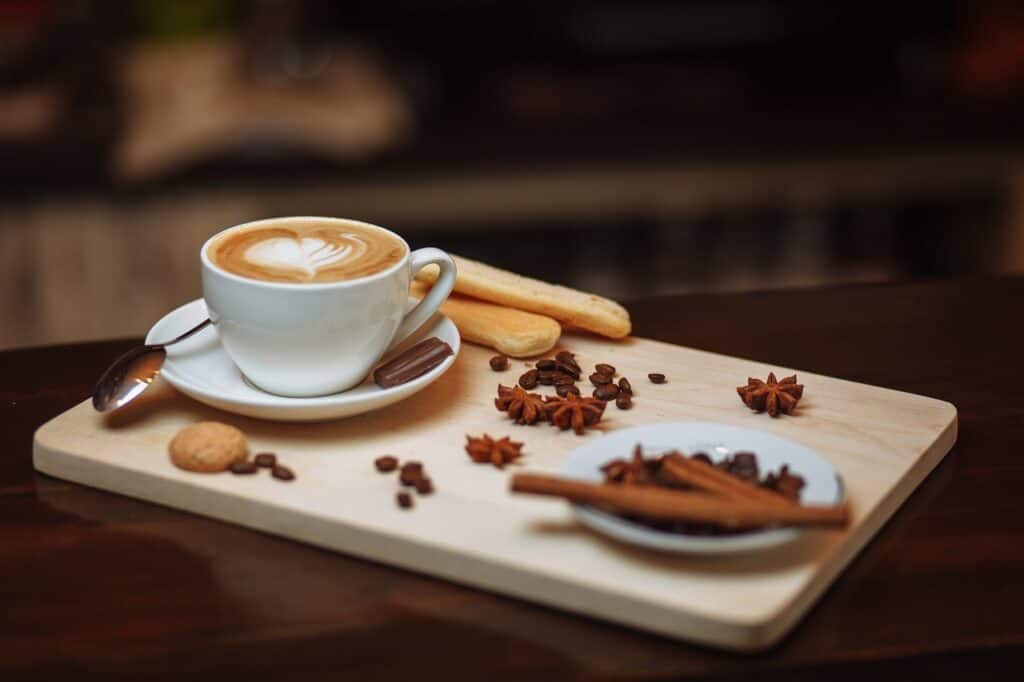What is Cappuccino Made Of: A Clear and Knowledgeable Explanation

Cappuccino is a popular coffee-based beverage that originated in Italy. It is a perfect drink for coffee lovers who prefer a creamy and frothy texture in their coffee. Cappuccino is made using three main ingredients – espresso, milk, and foam. The drink is prepared by pouring a shot of espresso into a cup, followed by steamed milk, and a layer of frothed milk on top.
Espresso is the foundation of a cappuccino. It is a concentrated coffee that is brewed by forcing hot water through finely ground coffee beans. The espresso shot used in cappuccino is typically a single or double shot. Milk is another essential ingredient in cappuccino. It is steamed to create a velvety, creamy texture that blends perfectly with the espresso. The milk used in cappuccino can be whole milk, skim milk, or any other type of milk depending on personal preferences.
Finally, the foam is the third key ingredient in cappuccino. It is created by aerating the milk with steam, which produces tiny bubbles that give the drink its signature frothy texture. The foam is spooned on top of the milk and espresso mixture to create the distinct three-layered appearance of a cappuccino. The ratio of espresso, milk, and foam can vary depending on the recipe, but a traditional cappuccino is typically made with equal parts of each ingredient.
History of Cappuccino
Cappuccino is a popular coffee drink that has been enjoyed for over a century. Its origins can be traced back to Italy, where it was first created in the early 1900s shortly after the introduction of the espresso machine in 1901. The drink was named after the Capuchin friars, a religious order known for their distinctive brown robes that closely resemble the color of the coffee and milk mixture.
According to a popular legend, cappuccino was invented by the Italian Capuchin friar Marco d’Aviano after the Battle of Vienna. However, this claim is unverified. The Viennese bestowed the name “Kapuziner” on an early version of cappuccino that included whipped cream and spices of unknown origin.
Italian cappuccino gradually gained popularity in cafes and restaurants across the country and eventually spread to other parts of Europe. The drink’s popularity continued to grow, and it eventually made its way to San Francisco in the 1950s, where it became a staple in many coffee shops.
Today, cappuccino is made by combining equal parts espresso, steamed milk, and milk foam. The espresso is poured into a cup, followed by steamed milk, and then topped with a layer of milk foam. The drink is often served with a sprinkle of cocoa powder or cinnamon on top.
In summary, cappuccino has a rich history that dates back to Italy in the early 1900s. Its popularity has spread throughout Europe and beyond, and it remains a beloved coffee drink to this day.
Main Ingredients
Cappuccino is a popular Italian coffee drink that is made up of three main ingredients: espresso, steamed milk, and frothed milk. Each of these ingredients plays an important role in creating the perfect cappuccino.
Espresso
Espresso is a concentrated coffee that is made by forcing hot water through finely ground coffee beans. A shot of espresso is the base of a cappuccino and gives the drink its strong, rich flavor. The size of the shot of espresso used in a cappuccino can vary depending on personal preference, but a standard shot is typically around one ounce.
Steamed Milk
Steamed milk is an essential component of a cappuccino. It is created by heating a small amount of milk with steam from an espresso machine. The steaming process creates a velvety texture and adds sweetness to the milk. Whole milk is typically used for steaming as it creates the best texture and flavor.
Frothed Milk
Frothed milk is created by aerating steamed milk with a steam wand on an espresso machine. This process adds air to the milk, creating a light and fluffy foam that is added to the top of the cappuccino. The foam should be thick enough to hold its shape but not so thick that it overpowers the espresso flavor.
In summary, a cappuccino is made up of a shot of espresso, steamed milk, and frothed milk. The balance between these ingredients is crucial in creating the perfect cappuccino. By using high-quality espresso and properly steamed and frothed milk, you can create a delicious and satisfying cappuccino.
Cappuccino Variations
Cappuccino is a classic Italian coffee drink that is made from espresso and steamed milk. However, there are several variations of cappuccino that differ in the ratio of espresso to milk and the texture of the milk foam. Here are some of the most popular cappuccino variations:
Dry Cappuccino
A dry cappuccino, also known as a “scuro” cappuccino, is a cappuccino that has more foam and less steamed milk than a traditional cappuccino. The foam is dry and stiff, and it sits on top of the espresso shot. The ratio of espresso to milk to foam is usually 1:1:2. A dry cappuccino is a good choice for those who prefer a stronger coffee flavor and a thicker foam.
Wet Cappuccino
A wet cappuccino, also known as a “chiaro” cappuccino, is a cappuccino that has more steamed milk and less foam than a traditional cappuccino. The texture of the milk is wet and creamy, and it blends with the espresso shot. The ratio of espresso to milk to foam is usually 1:2:1. A wet cappuccino is a good choice for those who prefer a milder coffee flavor and a creamier texture.
Latte
A latte, also known as a “caffe latte,” is a coffee drink that is similar to a wet cappuccino. It is made from espresso and steamed milk, but it has a higher ratio of milk to espresso. The texture of the milk is smooth and creamy, and it blends with the espresso shot. The ratio of espresso to milk is usually 1:3. A latte is a good choice for those who prefer a milder coffee flavor and a creamier texture.
Flat White
A flat white is a coffee drink that is similar to a latte, but it has a higher ratio of espresso to milk. It is made from espresso and steamed milk, but the texture of the milk is velvety and smooth. The ratio of espresso to milk is usually 1:2. A flat white is a good choice for those who prefer a stronger coffee flavor and a smoother texture.
Macchiato
A macchiato, also known as an “espresso macchiato,” is a coffee drink that is made from espresso and a small amount of milk foam. The texture of the milk foam is dry and stiff, and it sits on top of the espresso shot. The ratio of espresso to milk foam is usually 1:1. A macchiato is a good choice for those who prefer a strong coffee flavor and a thicker foam.
Cortado
A cortado, also known as a “piccolo latte,” is a coffee drink that is similar to a macchiato. It is made from espresso and steamed milk, but it has a higher ratio of milk to espresso than a macchiato. The texture of the milk is creamy and velvety, and it blends with the espresso shot. The ratio of espresso to milk is usually 1:1. A cortado is a good choice for those who prefer a milder coffee flavor and a creamier texture.
Cafe au Lait
A cafe au lait is a coffee drink that is similar to a wet cappuccino. It is made from brewed coffee and steamed milk, but it has a lower ratio of coffee to milk than a latte. The texture of the milk is creamy and velvety, and it blends with the coffee. The ratio of coffee to milk is usually 1:1. A cafe au lait is a good choice for those who prefer a milder coffee flavor and a creamier texture.
Overall, cappuccino variations offer a range of coffee flavors and textures to suit different tastes. From dry and strong to wet and creamy, there is a cappuccino variation for everyone to enjoy.
Preparation Process
Preparing a cappuccino requires the careful combination of espresso, steamed milk, and milk foam. Here is a step-by-step guide to making a delicious cappuccino.
Brewing the Espresso
To make a cappuccino, you will first need to brew a shot of espresso. This can be done using an espresso machine, which is a specialized coffee maker that is designed to produce a concentrated shot of coffee. To brew the espresso, simply fill the machine with water and coffee grounds, and then turn it on. The machine will then force hot water through the coffee grounds at high pressure, producing a rich and flavorful shot of espresso.
Steaming the Milk
Once you have brewed your espresso, it is time to steam the milk. This is done using a steam wand, which is a small metal tube that is attached to the espresso machine. To steam the milk, simply place the steam wand in a pitcher of cold milk and turn on the steam. The steam will heat the milk and create a creamy texture, which is essential for a good cappuccino.
Frothing the Milk
After steaming the milk, it is time to froth it. This is done by holding the steam wand just under the surface of the milk and turning on the steam. This will create a layer of foam on top of the milk, which is what gives a cappuccino its distinctive texture. Be sure to stop frothing the milk once it reaches the desired consistency.
Pouring the Cappuccino
To finish making your cappuccino, simply pour the steamed milk and foam over the espresso. The ratio of milk to espresso should be approximately 1:1, with a layer of foam on top. Be sure to pour slowly and carefully to create a beautiful design on top of the foam.
Overall, making a cappuccino requires a bit of practice and patience, but with the right tools and techniques, anyone can become a skilled barista. With a little experimentation and creativity, you can create a delicious cappuccino that is sure to impress your friends and family.
Cappuccino Characteristics
Cappuccino is a coffee drink that has a unique set of characteristics that make it stand out from other coffee beverages. In this section, we will discuss the flavor, texture, and appearance of a cappuccino.
Flavor
Cappuccino has a bold, rich, and creamy flavor. The espresso shot provides a strong and robust coffee flavor, while the foamed milk adds a creamy and sweet taste. The ratio of espresso to milk in a cappuccino is usually 1:1, which means that the coffee flavor is not overpowered by the milk.
Texture
The texture of a cappuccino is smooth, velvety, and creamy. The foam on top of the drink, also known as microfoam, is created by steaming and frothing the milk. The foam adds a light and airy texture to the drink, while the steamed milk gives it a smooth and creamy texture.
Appearance
Cappuccino is a visually appealing drink that is known for its latte art. The crema, which is the reddish-brown foam that forms on top of the espresso shot, adds a beautiful contrast to the white foam on top of the drink. The foam is usually spooned onto the drink in dollops, creating a layered effect. The latte art, which is created by pouring the foam in a specific pattern, adds a decorative touch to the drink.
In conclusion, cappuccino is a coffee drink that has a bold, rich, and creamy flavor, a smooth and velvety texture, and a visually appealing appearance. The foam on top of the drink, created by steaming and frothing the milk, adds a light and airy texture to the drink, while the crema and latte art add a beautiful contrast and decorative touch.

Additional Ingredients and Toppings
Cappuccinos are traditionally made with just two main ingredients: espresso and steamed milk. However, some people like to add additional ingredients or toppings to enhance the flavor or appearance of their cappuccino. Here are some common ones:
- Cream: Some people prefer to use cream instead of milk to create a richer, creamier cappuccino. Be aware that this will increase the calorie count significantly, so it may not be the best option if you’re watching your weight.
- Cinnamon: Adding a sprinkle of cinnamon to your cappuccino can give it a warm, spicy flavor that complements the coffee and milk. It can also make the drink look more visually appealing, especially if you create a decorative pattern with the cinnamon on top of the foam.
- Sugar: If you like your cappuccino on the sweeter side, you can add a little bit of sugar to the espresso before adding the steamed milk. Be careful not to add too much, though, as it can overpower the taste of the coffee.
- Cocoa Powder: Dusting a little bit of cocoa powder on top of the foam can give your cappuccino a chocolatey flavor and a beautiful, velvety finish. You can also use chocolate shavings or syrup for a more indulgent experience.
It’s worth noting that while these additional ingredients can add some variety and excitement to your cappuccino, they’re not necessary for a delicious cup of coffee. In fact, some purists would argue that adding anything beyond the basic espresso and milk is sacrilege. Ultimately, it comes down to personal taste and preference.
Nutritional Information
Cappuccino is a popular coffee drink that consists of espresso, steamed milk, and milk foam. It is a delicious beverage that can be enjoyed hot or cold, and it is a great option for coffee lovers who prefer a lighter and creamier taste than traditional espresso.
When it comes to nutritional information, a standard 16 fl oz (Grande) cappuccino from Starbucks contains 140 calories, 5g of total fat, 3g of saturated fat, 20mg of cholesterol, 120mg of sodium, 14g of total carbohydrates, 0g of dietary fiber, 12g of sugars, and 9g of protein. It also contains 150mg of caffeine, which can vary depending on the type of coffee beans used and the brewing process.
While cappuccino is not a low-calorie beverage, it can be a part of a healthy and balanced diet when consumed in moderation. It is important to note that the nutritional information can vary depending on the size and the ingredients used to make the cappuccino.
In terms of fat content, cappuccino contains a moderate amount of fat, with 5g of total fat and 3g of saturated fat. While this may seem high, it is important to remember that the milk used to make cappuccino is a significant source of fat. However, it is still lower in fat than many other popular coffee drinks, such as lattes and mochas.
When it comes to bitterness, cappuccino has a balanced taste that is not too bitter or too sweet. The espresso used in cappuccino provides a rich and robust flavor, while the steamed milk and milk foam add a creamy and slightly sweet taste to the beverage.
Overall, cappuccino can be a delicious and satisfying choice for coffee lovers. While it is not a low-calorie or low-fat option, it can be enjoyed as part of a healthy and balanced diet when consumed in moderation.
Perfect Cappuccino
To make a perfect cappuccino, you need to use high-quality ingredients and follow the right steps. Here are some tips to help you make the perfect cappuccino:
Temperature
The temperature of the milk is crucial in making a perfect cappuccino. You need to steam the milk to the right temperature to get the perfect texture. The ideal temperature for steaming milk is between 60°C and 65°C. If the milk is too cold, it won’t create enough foam, and if it’s too hot, it will scorch the milk and create a burnt taste.
Espresso
The espresso is the foundation of a cappuccino. You need to use a high-quality espresso that is freshly brewed. The espresso should be strong and have a rich flavor. You can use a single or double shot of espresso, depending on your preference.
Milk
The milk is an essential ingredient in a cappuccino. You need to use fresh, cold milk that has a high fat content. Whole milk works best for making cappuccinos as it creates a creamy texture and a rich flavor. You can also use non-dairy milk like almond or oat milk, but it won’t create the same texture and flavor as whole milk.
Foam
The foam is what gives a cappuccino its signature texture. You need to create a thick and creamy foam to top your cappuccino. To create the perfect foam, you need to steam the milk correctly. You should tilt the pitcher slightly and place the steam wand just below the surface of the milk. As the milk starts to foam, you should lower the pitcher to create a swirling motion. This will help distribute the foam evenly and create a velvety texture.
In conclusion, making a perfect cappuccino requires the right ingredients, temperature, and technique. By following these tips, you can create a delicious and satisfying cappuccino that will impress even the most discerning coffee connoisseur.

Frequently Asked Questions
What is the difference between cappuccino and latte?
Cappuccino and latte are both espresso-based drinks, but the difference lies in the ratio of milk to espresso. A cappuccino has a 1:1:1 ratio of espresso, steamed milk, and milk foam, while a latte has a 1:2 ratio of espresso and steamed milk. Additionally, a latte typically has less milk foam than a cappuccino.
How do you make a cappuccino?
To make a cappuccino, you will need to pull a shot of espresso and steam milk. Pour the steamed milk into the espresso, leaving room for milk foam. Spoon the milk foam on top of the drink, creating a layered effect. The ratio of espresso, steamed milk, and milk foam should be 1:1:1.
What is the difference between cappuccino and macchiato?
A cappuccino is made with espresso, steamed milk, and milk foam, while a macchiato is made with espresso and a small amount of milk foam. The word “macchiato” means “stained” in Italian, referring to the small amount of milk foam that is added to the espresso.
What is the difference between cappuccino, latte, and flat white?
Cappuccino, latte, and flat white are all espresso-based drinks with varying ratios of espresso to milk. A cappuccino has a 1:1:1 ratio of espresso, steamed milk, and milk foam. A latte has a 1:2 ratio of espresso and steamed milk, with a small amount of milk foam on top. A flat white has a 1:3 or 1:4 ratio of espresso and steamed milk, with a thin layer of microfoam on top.
What is a latte?
A latte is an espresso-based drink made with steamed milk and a small amount of milk foam. The ratio of espresso to milk is typically 1:2, and the drink is often served in a larger cup than a cappuccino.
Which is stronger: latte or cappuccino?
A cappuccino and a latte have the same amount of espresso, so their strength is the same. However, a cappuccino may taste stronger due to the presence of more milk foam, which can create a bolder flavor.






One Comment